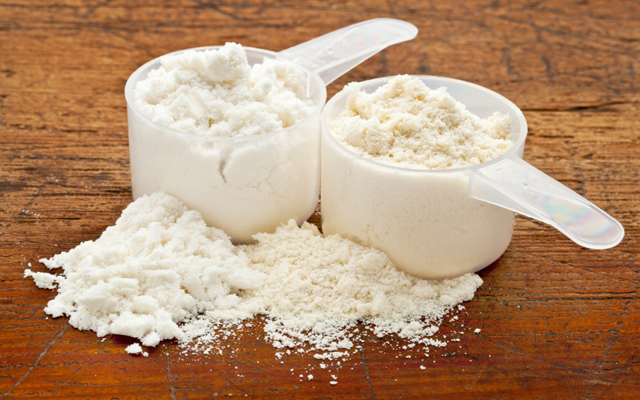
Protein type, amount, and timing are all important, but what about the different forms of whey protein?
When it comes to protein, type, amount, and timing are all important. Research shows that whey protein is one of the best, if not the best, protein source to consume regularly for maximum satiety, thermogenesis, and muscle protein synthesis (1-3). To truly reap those benefits, studies support consuming 20 to 40 grams of protein at each meal as well as after strenuous workouts (4).
But what about the form of whey protein? Concentrate, isolate, hydrolysate—is one better than the others? Some people may swear that one reigns supreme and the others aren’t even worth putting in your body. Let’s break down the science.
Protein Components, Absorption, and Bioavailability
Before talking about which protein form is best, it’s important to consider how protein works in the body once you consume it, and why whey protein is better than other types. The nutritional effects a protein exerts on the body mainly depends on its amino acid profile, the rate of absorption, and the bioavailability of the amino acids once inside the body.
One of the reasons whey protein is superior to other protein types is because it contains all of the amino acids necessary for supporting optimal muscle tissue growth, and maintenance. Whey is a complete protein, which means it contains all essential amino acids (ones the body can’t make).
Of particular interest, especially for muscle building, is the fact that whey protein naturally has the highest percentage of branched-chain amino acids including leucine, which plays the biggest part in muscle protein synthesis.
Because whey protein is a good source of the sulfur-containing amino acids cysteine and methionine, it also benefits the immune system. Cysteine and methionine are used to make glutathione, which protects DNA from damage during cell division and maintains antioxidant status in the body (5).
Once a protein is consumed, the next step in the process is digestion. Whey protein is easily and rapidly digested and absorbed. As a result, amino acids are readily available to muscle and can be used to support muscle growth and recovery better than other protein sources such as soy. (6).
Another important aspect to consider when choosing the best protein is Biological Value (BV), which measures how much of the protein can actually be used by the body. For example, an egg has a BV of 100, meaning 100 percent of the amino acids are used by the body to make, or maintain tissue. Whey protein has the highest BV among proteins at 104 (7).
No matter the form of whey protein, the aforementioned benefits are still there. Only slightly different, here’s the breakdown and potential benefits of the three different forms of whey protein:
Whey protein concentrate typically contains around 80 percent protein in addition to a small amount of fat, minerals, and lactose. Because it’s more complete, whey protein concentrate usually has more bioactive components and proteins that add to concentrate’s benefit (7). Concentrate is a very suitable form of whey protein for use in complete meal replacements (like IsaLean Shake and IsaLean Pro) for its overall benefit.
Whey protein isolate is the isolated protein fraction from whey protein concentrate providing 90 percent or more of protein—making it the purest protein source. Some people believe this form to be the best because of its purity. While purity is certainly a positive attribute, many isolates don’t have the other benefits of concentrate due to bioactive components and proteins being broken down during processing (7). Whey protein isolates are typically used in “muscle-minded” products aimed at bodybuilders and are also widely used in snack and meal replacement bars.
Whey protein hydrolysate is predigested, meaning the long chains of amino acids typically found in isolates and concentrates are broken down into single amino acids. This is similar to what happens in our own bodies during digestion. Because whey hydrolysate is predigested, it’s thought to result in faster absorption and release of amino acids into the blood stream, which may lead to slightly greater muscle protein synthesis when ingested after exercise (8). For this reason, whey protein hydrolysates are used mainly in bodybuilding supplements. However, studies have shown that because whey protein absorbs so quickly in its original form, predigesting it to a hydrolysate does not lead to significantly faster absorption (9). Also, whey hydrolysate has a bitter flavor, which must be masked with heavy use of sweeteners and flavoring to make palatable (10). And as with isolate, the destruction of amino acid chains leads to less support of the immune system and antioxidant status in the body compared to concentrate.
The various whey protein forms all have positive attributes—one is more complete and possibly more bioactive, one has a higher protein percentage, and one is predigested with the idea that amino acid absorption is faster. However, there have yet to be studies to confirm that one form is better than the rest with long-term use. The bottom line: All three forms of whey protein can result in weight loss and maintenance, muscle building and retention, and benefit to overall health.
References
- Chungchunlam SM, Henare SJ, Ganesh S, Moughan PJ. Effect of whey protein and glycomacropeptide on measures of satiety in normal-weight adult women. Appetite 2014;78C:172-8.
- Miller PE, Alexander DD, Perez V. Effects of whey protein and resistance exercise on body composition: a meta-analysis of randomized controlled trials. J Am Coll Nutr 2014;33:163-75.
- Tang JE, Moore DR, Kujbida GW, et al. Ingestion of whey hydrolysate, casein, or soy protein isolate: effects on mixed muscle protein synthesis at rest and following resistance exercise in young men. J Appl Physiol 107: 987-992, 2009.
- Mamerow MM, Mettler JA, English KL et al. Dietary Protein Distribution Positively Influences 24-h Muscle Protein Synthesis in Healthy Adults. J Nutr 2014.
- Anand S, Khanal Sm, Marella C. (2013) Whey and whey products. In: Milk and Dairy Products in Human Nutrition (eds Y. Park & G. Haenlein), pp.477-497. John Wiley & Sons, Ltd., West Sussex, UK.
- Fouillet H, Mariotti F, Gaudichon C, et al. Peripheral and splanchnic metabolism of dietary nitrogen are differently affected by the protein source in humans as assessed by compartmental modeling. J Nutr 2002;132:125-33.
- Hoffman JR, Falvo MJ. Protein – Which is Best? J Sports Sci Med 2004;3:118-30.
- Kanda A, Ishijima T, Shinozaki F et al. Post-exercise impact of ingested whey protein hydrolysate on gene expression profiles in rat skeletal muscle: activation of extracellular signal-regulated kinase 1/2 and hypoxia-inducible factor-1alpha. Br J Nutr 2014;1-12.
- Power O, Hallihan A, Jakeman P. Human insulinotropic response to oral ingestion of native and hydrolysed whey protein. Amino Acids. 2009;37:333–9.
- Leksrisompong P, Gerard P, Lopetcharat K, Drake M. Bitter taste inhibiting agents for whey protein hydrolysate and whey protein hydrolysate beverages. J Food Sci 2012;77:S282-S287.





